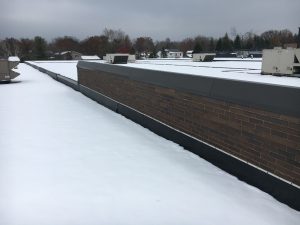— By Steve Smith —
Start of spring is go-time for facility managers to assess and repair winter roof damage and prepare for spring showers.
With the start of spring, facility managers of commercial buildings across the country are advised to immediately inspect their roofing to assess damage from the winter months and make necessary repairs before the showers of spring begin. Commercial roofing service providers recommend taking advantage of this window of opportunity between winter and spring to avoid costly repairs resulting from neglect.

Steve Smith, Legacy Roofing Services
In many cases, winter damage to roofing does not become apparent until after temperatures begin to rise — which makes the start of spring the ideal time to inspect roofing and identify and repair problems before April showers begin. This is also the time of year when facility managers should put a preventative maintenance routine in place for their roofing system.
Some of the more common commercial roofing issues caused by winter weather:
- Enlargement of openings and cracks caused by the expansion of water when it freezes.
- Debris and tree limbs that blew or fell onto the roof that went unnoticed because of snow or less activity on the roof during winter.
- Clogged drains and gutters from dirt and debris in melting ice and snow.
- Grease spillage due to frozen grease traps not functioning properly.
- Openings and missing fasteners in metal roofing from the expansion and contraction of the galvanized steel.
- Granule loss, punctures and tears in modified roof systems.
- Formation of gaps and cracks in older asphalt built up roofs that have “alligatoring,” or blistering.
- Damage done by fallen panels and covers from HVAC systems and other equipment located on the roof.
In addition to assessing and repairing winter damage at the start of spring, experts advise facility managers to dedicate resources to a solid preventative maintenance regimen that will ultimately extend the life of the roof and, in many cases, the manufacturer’s warranty. The goal of preventative maintenance is to stop problems before they start and avoid costly repairs and replacements. Preventative maintenance can be difficult to do during the winter months, which is why it is recommended with the start of spring.
 Spring also brings its own set of challenges for which facility managers should be prepared. Depending on the part of the country, many commercial buildings will face more rain during the spring than any other time of year. This means even the smallest of leaks can turn into a highly troublesome and expensive problem if not addressed early. Unlike residential roofing, commercial roofs are usually flat — which means excessive rain can result in ponding and sit on the roof for longer periods of time making it even more critical to address any problems that are compromising the integrity of the roof. Again, depending on the location of the building, spring also marks the debut of the summer sun with potentially damaging heat and ultraviolet rays beating down on the roof every day for several months. This can lead to the formation of cracks and other openings that can cause larger issues as time goes on.
Spring also brings its own set of challenges for which facility managers should be prepared. Depending on the part of the country, many commercial buildings will face more rain during the spring than any other time of year. This means even the smallest of leaks can turn into a highly troublesome and expensive problem if not addressed early. Unlike residential roofing, commercial roofs are usually flat — which means excessive rain can result in ponding and sit on the roof for longer periods of time making it even more critical to address any problems that are compromising the integrity of the roof. Again, depending on the location of the building, spring also marks the debut of the summer sun with potentially damaging heat and ultraviolet rays beating down on the roof every day for several months. This can lead to the formation of cracks and other openings that can cause larger issues as time goes on.
Regular inspection, assessment, repair and preventative maintenance are key components of getting the most out of a roof and avoiding costly surprises. The whole notion of ‘if it ain’t broke, don’t fix it’ does not apply to roofing — preventative maintenance will pay for itself exponentially.
— Steve Smith is vice president of the commercial roofing division of Legacy Roofing Services, one of the largest commercial roofing service providers in the United States, managing more than 5 million square feet of roofing every year. The company provides a wide array of installation, repair and maintenance services using the latest technologies, including infrared scanning, a fleet of UAS drones and a proprietary online project management portal. The Cleveland, Ohio-based company was founded in 2012 and primarily operates in the Midwestern and Southeastern United States. For more information, visit www.LegacyRoofing.com.
EDITOR’S NOTE: This article originally appeared in the April 2020 issue of Retail & Restaurant Facility Business magazine, which went to print prior to the widespread onset of COVID-19.
